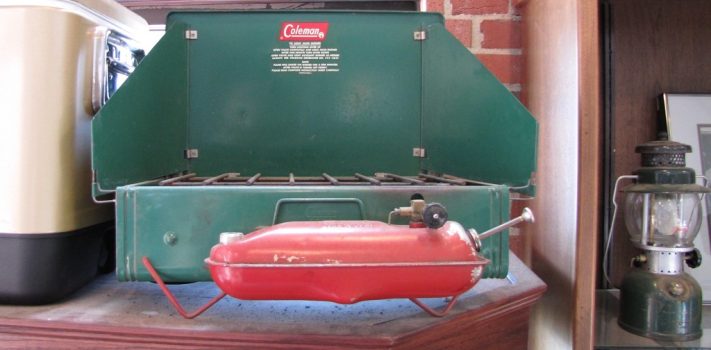A few months ago, my father gave me some camping gear he bought in the 1970s when he and my oldest brother started camping. He gave me a red Coleman lantern, and a large, green Coleman, dual burner stove. I remember using both pieces on occasion when he took me camping as a young boy. On the last camping trip we did together, when I was in college, neither the stove nor lantern would work. It was a dark night, and our food was cold. Both pieces were put on the shelf for many years.
I have rebuilt many stoves and lanterns and am very familiar with what parts are the usual suspects when they don’t work. Both stoves and lanterns are very simple and have very few parts, so diagnosis is usually quick and easy and so is correcting the issue. Nine times out of ten, the main problem is the leather or cork pump cup. Over time, it becomes brittle and dry resulting in a leaky seal when pressurizing the fuel tank. Until a couple of years ago, most stores that had a sporting goods aisle had replacement silk mantles and Coleman rebuild kits on hand. They were commonly found and always in stock. At one point, I bought half a dozen or so of these kits to have on hand.
Over the years, as I rebuilt miscellaneous stoves and lanterns, I used up most of the parts in those kits I had stocked up on, so when I started taking my dad’s stove and lantern apart, I did not have a complete kit available. I went by every local store that used to carry the rebuild kits and I could not believe how difficult it was to find the Coleman lantern/stove rebuild kits. They used to be quite common. I suppose that less and less people use the old-style stoves, so the rebuild kits take up shelf space and do not sell very often. I ended up buying two rebuild kits online.
When I brought the stove and lantern home, I immediately took them apart and replaced the original, brittle leather plunger cups with new rubber ones. After replacing those, and oiling the plunger tubes, the lantern still did not work, and the stove barely worked. I did a little research, which led me down the path of tearing both the lantern and stove completely apart. I used fine grit sandpaper to remove any rust and dirt buildup, and liberally used carburetor cleaner over everything.
After several reassemblies, I admitted defeat and gave up on the lantern. I shelved it for a future date when I could dedicate more time to it. There’s a blockage somewhere as it’s got plenty of pressure in the fuel tank, but there is no fuel being delivered to the mantles.
The stove on the other hand worked better after the new rubber cup, but it still didn’t work great. The air and fuel mixture was off and the flames were very weak. Disheartened, I shelved the stove for a later date as well. I had never had so many issues rebuilding any stove or lantern in the past. The fact they were my father’s just added salt to the wound. Knowing of my frustration, my wife bought a Stansport propane conversion adapter for the stove as a Christmas gift.
I had heard about these adapters, but had never given it a thought to try one out. The adapter plugs into the same spot the old Coleman fuel tank line goes, and is held tight by a spring that attaches to the stove. There is a fuel knob on the adapter that controls the amount of fuel going into the stove. I could not wait to try it out on the stove. Assembly was quick. It took longer to thread a one-pound propane bottle onto the adapter than anything else. I turned the fuel knob and heard the hiss of propane coming from the burner. I put a lighter close to the right side, main burner and as soon as I flicked it, a blue flame took off creating a perfect 360 degree flame all the way around the burner. I was ecstatic! I turned the side valve, which controls the left burner, and lit it with the lighter as well. It too worked perfectly. The flames were strong, and the stove was working like new.
The lantern(s) and stoves that my family uses while camping, hunting, and fishing are all fueled by propane. It is relaxing to know all the fuels are the same and are easily stored. I am not sure about other Coleman stoves, but the one my father gave me, is big enough to fit the adapter and a single, one-pound propane bottle in the same place the old white gas fuel tank originally stored. In the near future, I am going to buy a braided stainless hose adapter which will allow me to run my propane camping stoves, and a stationary lantern, off a BBQ-sized, or larger, propane tank. The hose has a built-in regulator and being stainless, it should last a very long time, even if left in the elements.
I love the simplicity, yet nostalgic feeling this stove has. More than anything, I appreciate that my kids, and possibly their kids will have the chance to use the stove my father bought new to create lon- lasting memories because of a twenty-five-dollar adapter.
I’m one happy camper,










